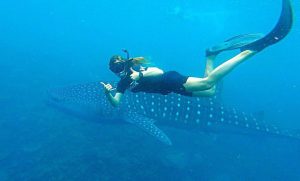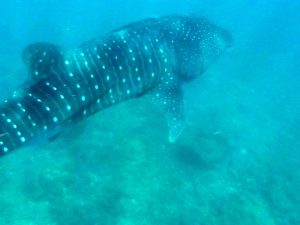What is it? A shark? A whale? Whatever it is it’s massive!’
The whale shark is the biggest fish in the ocean, and therefore is also the biggest shark. It is one of three species of filter feeding shark; also including the basking shark and the mega mouth shark. On the 7th January we were lucky enough to spot Pedro who is a juvenile male at six metres. It was a truly breathtaking moment! The best time to look for a whale shark is three to five hours before high tide and a few days before the full moon. However, finding a whale shark cannot be a guaranteed experience.


For many, seeing a whale shark is a once in a lifetime experience, with a place at the top of numerous bucket lists. These enigmatic and gentle creatures can be seen year round in South Ari Atoll, only a short seaplane ride from Gili Lankanfushi. The whale sharks are attracted to South Ari Atoll due to the vicinity of the Chagos-Laccadive Plateau, which provides very deep and highly nutrient rich water. Whale sharks are a pelagic species, able to travel around 100 miles per day and dive to at least 1600m – probably deeper, but this cannot be officially recorded due to tracking tags breaking under the phenomenal pressure at great depth.
Whale sharks are fascinating animals that predate the dinosaurs by 220 million years. All sharks, including the whale shark are cartilaginous fish, which means that their skeletons are made from cartilage, not bone. As with all sharks the whale shark’s skin is covered by dermal denticles, a substance more like teeth than fish scales. The dermal denticles are a couple of millimeters thick and protect the shark’s skin from damage and parasites. They also provide better hydrodynamics. Under this layer of protective armour is a fatty layer, around 10 to 15 cm thick that is most likely used as an energy store and protection from injuries, together with insulation during deeper dives. Whale sharks have over 300 rows of tiny replaceable teeth which are made from a stronger version of dermal denticles. Scientists are still debating the use of these teeth as whale sharks are filter feeders so their teeth are not required for feeding. Another anatomical feature which perplexes scientists is that the whale shark has spiracles. These are a breathing aid for stationary sharks, but the whale shark is classified as a highly mobile shark so what is the use? It could be that the whale shark is very closely related to bottom dwelling sharks, and it is a feature that will eventually disappear through evolution, or it could be used on the rare occasions that the shark is stationary and not feeding.

Whale sharks are known to make seasonal feeding aggregations in 20 countries, including Australia, Gulf of Mexico, Belize, Gulf of California, Seychelles and Maldives. Whale sharks feed on microscopic plankton and small fish that they suck into their one and half metre wide mouths. Their throats are much smaller in comparison; around the size of a drain pipe. They have two known methods for feeding, ram filtration and suction feeding. Suction feeding allows whale sharks to feed on more mobile prey such as small fishes, which they actively suck into their mouths, together with volumes of water that are then expelled through their gills. By comparison ram feeding is passive; the shark swims through the water with their mouth open and plankton filters in. It has been suggested that whale sharks are more suited to suction filter feeding because the gaps between their five to seven gills are small. This small gap is more effective at filtering out plankton when the shark is suction feeding. Whale sharks have very weak eyesight, they can probably only see three meters away, and so rely on their nostrils to find prey. Their nostrils are very sensitive due to their well-developed olfactory capsules; they can detect chemicals in the water produced by their planktonic prey.
Plankton tend to shelter at depths between 100 – 200m. This is the oxygen minimum zone and is not a suitable habitat for many organisms which would prey on them. Whale sharks however are able to feed at these depths and will spend the majority of their time between 50 – 250m. They do venture to deeper depths where the temperature drops to 3 degrees Celsius but scientists believe that due to the infrequency of these dives this is related to parasite removal, not feeding. Whale sharks cannot internally control their body temperature and so return to the surface to warm up and reload oxygen. This is why they can be found in the shallow waters around South Ari Atoll. During this warming and reloading period the sharks can be impaired cognitively and physically which explains their sluggish and relaxed behaviour.
Due to the sluggish behaviour of whale sharks and the shallow depths they travel in they are under threats from boats. It is estimated that 67% of whale sharks have injuries ranging from scratches to amputations. The effects of pollution, poor waste management and increased sedimentation on the whale shark population have not yet been suitably evaluated. Another issue is disturbances to their habitat resulting from tourism – if the guidelines for whale shark encounters are not followed the sharks can negatively be affected. For example, if a large group of tourists are crowding a shark it can cause the shark to dive before it has properly warmed up and reloaded oxygen. Adult whale sharks can also be targeted by great white sharks and orcas, whilst babies have been found in the stomachs of blue sharks and swordfish. In some parts of the world whale sharks are hunted for their meat and fins. In 2010 the Maldives implemented a ban on all forms of shark fishing. However, due to the longevity of whale sharks it will take many years for the population to return to optimal levels.

It is estimated that whale sharks can live between 70 – 100 years, reaching sexual maturity after 25 years at a size of eight to nine metres. Although some people report sightings of whale sharks up to 18 metres in length the largest confirmed has been 12.65m. It is easy to identify a male whale shark because when it has reached sexual maturity their sexual organs have a ragged appearance called claspers which extend past their pelvic fin. The whale shark is classified as ovoviviparous which means that they produce eggs which hatch inside the body. A female whale shark can store sperm for many months and can have babies at different stages of development. For example a female was found with 300 embryos at numerous stages of development. Due to whale sharks storing sperm and having babies at different stages of development the gestation period is unknown. Upon birth the pups are around half a metre in size and weight one kilo.
Whilst whale sharks are regularly sighted, 98% of these sightings are juvenile males with a length of six metres. At any one point it is estimated that there are 200 whale sharks in the waters of the Maldives. The most common behaviour observed of these sharks is cruising, only 12% of encounters are feeding.
We can’t wait to show you these gentle giants next time you are at Gili Lankanfushi. Please ask your Mr/Ms Friday and we can book a trip for you. When you see one be sure to snap a photo of the checkerboard pattern on their side by their pectoral fins. This can help us with identification and research.
For more information and to upload your whale shark encounters please visit: https://maldiveswhalesharkresearch.org/